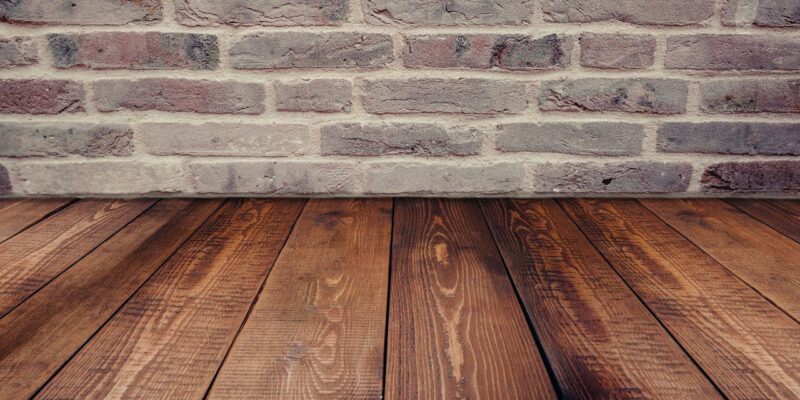Floors shape the entire atmosphere of a rustic space. Texture underfoot reflects tradition, purpose, and permanence. Patterns in grain, subtle cracks in stone, and uneven tones in earth-sourced material each carry visual weight.
Design grounded in rustic principles depends on material honesty. Every surface must hold presence without polish. Character comes through imperfections, not gloss. Longevity matters more than trend.
Each flooring type included below fits naturally within rustic interiors.
1. African Hardwood Flooring
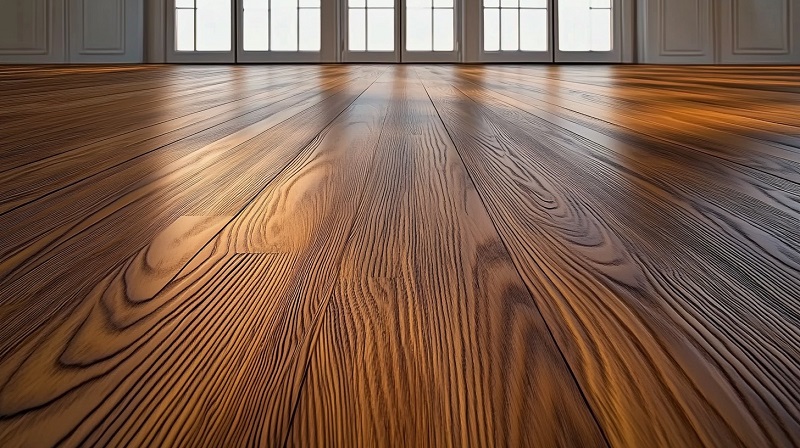
African hardwood remains a cornerstone in rustic design, valued for its density, durability, and natural richness. Found in both traditional homes and high-end interiors, it combines beauty with long-lasting strength.
Key Characteristics of African Hardwoods
- Iroko: Often labeled as African Teak, shows golden-brown tones that darken with time
- Mahogany: Smooth surface, reddish depth, great for warm rustic themes
- Teak: High oil content, excellent for temperature and moisture shifts
- Ebony: Dense, dark, bold grain, ideal for dramatic rustic statements
Installation Advice
Proper installation ensures lasting performance. Every plank must adjust to the room’s climate before fitting. This step prevents warping or cracking.
- Allow wood to acclimate 5 to 7 days indoors
- Use experienced installers familiar with hardwood expansion gaps
- Choose finishes that enhance grain rather than seal it completely
- Opt for oil-based treatments for a natural, breathable surface
Where to Use It
African hardwoods shine in open living rooms, entry halls, and even rustic kitchens. Their weight and character give rooms an immediate grounded feel.
- Avoid in below-grade basements unless properly treated
- Perfect for interiors exposed to direct sunlight or seasonal humidity shifts
- Ideal for mixing with natural stone or wrought iron element
2. Thin Brick Flooring

Thin brick introduces a raw, earthy layer to rustic interiors. Its irregular texture and clay-based surface capture a worn-in, timeless feel. Unlike full bricks, thin bricks are lightweight and easy to apply across subfloors without added structural support.
Why Thin Brick Works in Rustic Design
- Natural texture with slight variation in color and shape
- Low profile allows installation in places where traditional brick would be too bulky
- Matches wood beams and aged plaster walls for old-world appeal
Installation Tips
Surface prep matters. Thin brick needs a firm and level underlayment.
- Use a cement backer board or concrete base
- Apply thin-set mortar evenly, spacing with tile spacers
- Grout with a bag or trowel method for rustic, irregular joints
- Seal surface after curing to protect color and prevent staining
Best Rooms for Thin Brick Floors
Brick products fit well in spaces that call for age and authenticity. It thrives in rooms where natural wear is an asset, not a flaw.
- Mudrooms and foyers that face heavy foot traffic
- Wine cellars and kitchen floors for a Mediterranean or farmhouse look
- Covered patios with a mix of stone, wood, and metal accents
3. Natural Stone Flooring
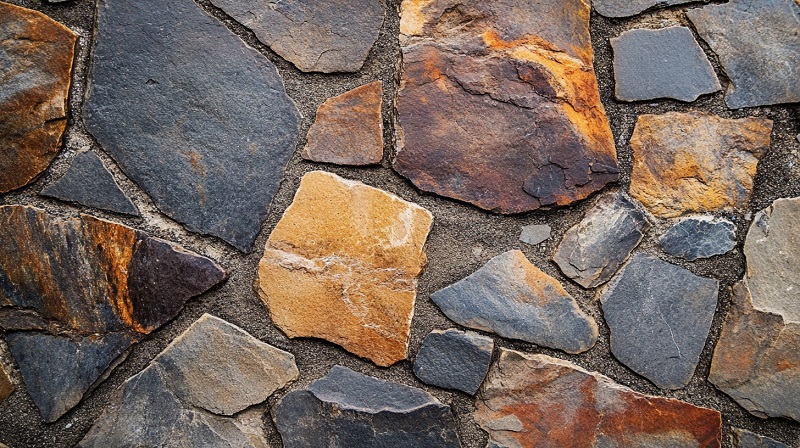
Natural stone offers unmatched permanence and raw elegance. It brings geological depth to rustic interiors. No two slabs are identical, which makes every installation completely unique.
Stone flooring fits rural cottages, lodge-style homes, and traditional compounds across many regions.
Common Stone Types for Rustic Spaces
- Slate: Layered texture, natural grip, deep gray and olive tones
- Limestone: Softer, lighter color palette with smooth surface
- Granite: Durable, speckled, high resistance to scratches and wear
- Sandstone: Earthy tones with fine-grained surface variation
Installation and Maintenance
Stone flooring requires precision and preparation. Uneven subfloors cause breakage. Moisture management is key, especially in humid areas.
- Always seal porous stones like limestone and sandstone
- Use a breathable underlayment to allow expansion
- Sweep frequently and mop with pH-neutral cleaner
- Avoid acids or bleaches that damage surface minerals
Interior Placement Ideas
View this post on Instagram
Stone floors hold up well in high-impact zones. Their thermal properties add comfort in both hot and cold climates.
- Entryways with heavy foot traffic
- Dining areas combined with wooden furniture
- Bathrooms and laundry rooms with proper anti-slip treatment
Natural stone carries ancestral charm. Each slab connects to land, age, and permanence. It anchors a rustic design like no other material.
4. Polished Concrete Floors
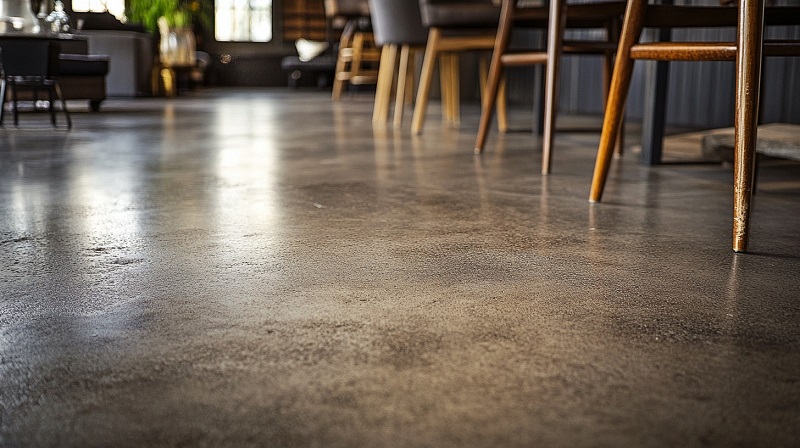
Polished concrete offers a refined industrial contrast to rustic textures. Its smooth, matte surface reflects light gently, giving rooms a calm, grounded base. It suits cabins, renovated barns, and modern rustic blends.
Features That Stand Out
- Thermal mass helps stabilize interior temperature
- Low maintenance with long wear life
- Dust-free surface compared to unfinished concrete
Preparation and Finishing
Concrete must be poured level and cured fully before polishing begins.
- Use densifiers to harden the surface before polishing
- Diamond polishers create gradual sheen without gloss
- Seal with matte or satin finish for rustic authenticity
- Add pigment or exposed aggregate for extra character
Best Uses Indoors
Polished concrete works where simplicity meets durability. It forms a clean contrast with wood, leather, and iron.
- Living rooms with large windows and open layouts
- Kitchens where spills and heavy wear occur often
- Studios and workshops needing functional design
5. Reclaimed Wood Flooring
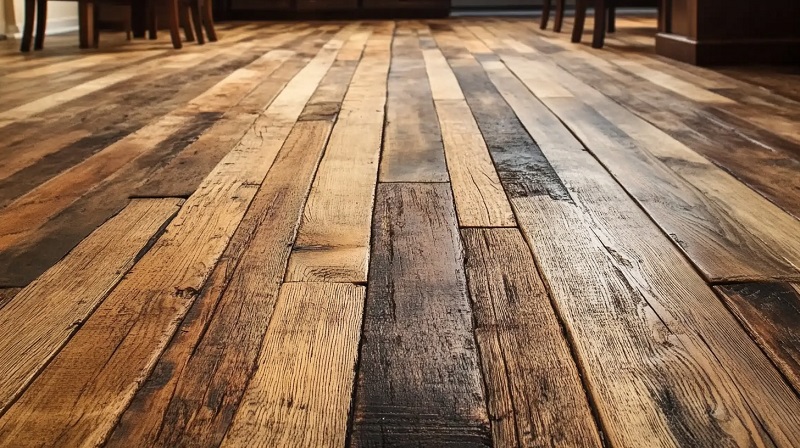
Reclaimed wood offers more than aged beauty. It gives interiors a visible history. Each board once formed part of a barn, mill, or factory. Those years of use left marks, grooves, and character that cannot be reproduced.
Types of Reclaimed Wood
- Oak: Hard, dense, filled with patina and old saw marks
- Pine: Softer, warmer tone, with rustic knots
- Chestnut: Rare, light grain, often worm-holed or weathered
- Maple: Tight grain with good hardness
Working With Reclaimed Wood
Not every board arrives in perfect shape. Cleaning, milling, and finishing are essential steps.
- De-nail and clean each board thoroughly
- Flatten and trim to uniform sizes before installation
- Use low-sheen oil finishes to preserve original texture
- Mix widths and lengths for authentic appearance
Where It Works Best
Reclaimed wood suits interiors that celebrate imperfection and authenticity.
- Bedrooms with exposed beams and heavy textiles
- Family rooms with fireplaces and large windows
- Attic spaces transformed into warm retreats
6. Bamboo Flooring
Bamboo delivers strength, style, and sustainability. Though technically a grass, it behaves like hardwood. Its natural pattern works well in clean rustic interiors that favor simplicity over ornamentation.
Bamboo Flooring Varieties
- Strand-woven: Highest durability, suitable for heavy wear
- Horizontal grain: Visible knots for rustic pattern
- Vertical grain: Clean lines for modern rustic blend
Installation and Care
Bamboo needs time to settle before installation. Moisture levels must match the environment.
- Allow to acclimate indoors 72 hours before install
- Use floating, nail-down, or glue-down methods depending on subfloor
- Clean with microfiber mop and avoid excess water
- Apply floor protectors to avoid denting under furniture
Ideal Interior Uses
Bamboo balances clean lines with organic warmth. It thrives in well-lit spaces and works best against neutral walls.
- Bedrooms and nurseries for quiet comfort
- Dining rooms with modern rustic table settings
- Home offices blending nature and focus
Grounded Beauty Built to Last
Rustic interiors demand more than visual style. Every flooring choice must serve a purpose, hold its weight, and connect to something older than fashion. Grain, stone, clay, and concrete do not pretend. They show age, use, and permanence without apology.
Each material in this list speaks to different needs. Some fit historic homes. Others work better in updated spaces that still honor tradition. African hardwood adds legacy. Thin bricks offer tactile depth. Stone grounds a room with quiet power. Concrete simplifies. Reclaimed wood remembers. Bamboo renews.
No matter the material, the goal remains the same: to create spaces where surfaces feel earned, not applied. Rustic design does not begin with paint or furniture. It begins with the floor. That is where character lives longest.








